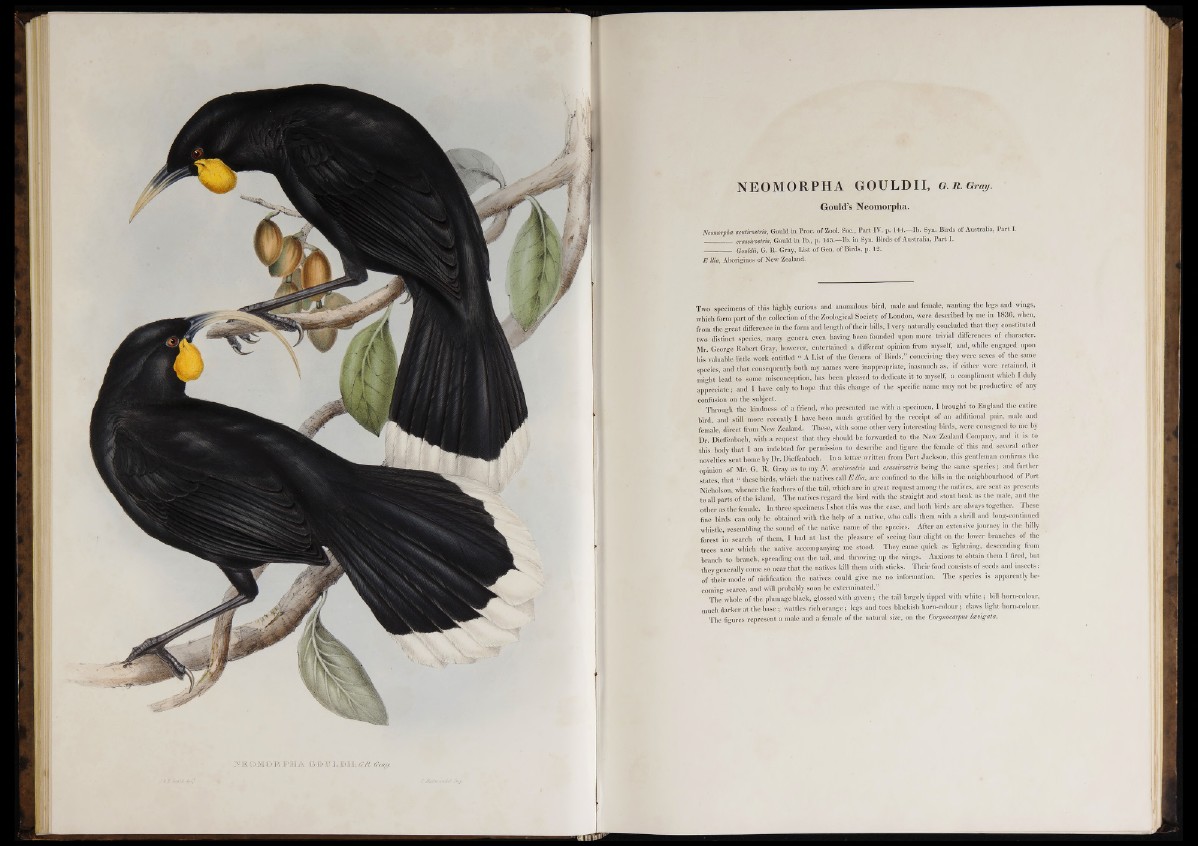
NEOMORPHA GOULDII, G. R . G ray.
Gould’s Neomorpha.
Neomorpha acutirostris, Gould in Proc. of Zool. Soc., Part IV. p. 144.—Ib. Syn. Birds of Australia, Part I.
________ crassirostris, Gould in Ib., p. 145—Ib. in Syn. Birds of Australia, Part I.
— Gouldii, G, R. Gray, List of Gen. of Birds, p. 12.
E Ilia, Aborigines of New Zealand.
Two specimens of this highly curious and anomalous bird, male and female, wanting the legs and wings,
which form part o f the collection of the Zoological Society of London, were described by me in 1836, when,
from the great difference in the form and length of their bills, I very naturally concluded that they constituted
two distinct species, many genera even having been founded upon more trivial differences of character.
Mr. George Robert Gray, however, entertained a different opinion from myself, and, while engaged upon
his valuable little work entitled “ A List o f the Genera of Birds,” conceiving they were sexes of the same
species, and that consequently both my names were inappropriate, inasmuch as, if either were retained, it
might lead to some misconception, has been pleased to dedicate it to myself, a compliment which I duly
appreciate; and I have only to hope that this change of the specific name may not be productive of any
confusion on the subject.
Through the kindness o f a friend, who presented me with a specimen, I brought to England the entire
bird, and still more recently I have been much gratified by the receipt of an additional pair, male and
female, direct from New’Zealand. These, with some other very interesting birds, were consigned to me by
Dr. Dieffenbaçh, with a request that they should be forwarded to the New Zealand Company, and it is to
this body that I am indebted for permission to describe and figure the female of this and several other
novelties sent home by Dr. Dieffenbach. In a letter written from Port Jackson, this gentleman, confirms the
opinion of Mr. G. R. Gray as to my N . acutirostris and crassirostris being the same species; and further
states, that “ these birds, which the natives call E Ilia, are confined to the hills in the neighbourhood of Port
' Nicholson, whence the feathers o f the tail, which are in great request among the natives, are sent as presents
to all parts of the island. The natives regard the bird with the straight and stout beak as the male, and the
other as the female. In three specimens I shot this was the case, and both birds are always together. These
fine birds can only be obtained with the help of a native, who calls them with a shrill and long-continued
whistle,,resembling the sound of the native name of the species. After an extensive journey in the hilly
forest in search of them, I had at last the pleasure o f seciuu four alight oh the lower branches of the
trees near which the native accompanying me stood. They came quick as lightning, descending from
branch to branch, spreading out. the tail, and throwing up the wings. Anxious to obtain them I fired, but
they generally come so near that the natives kill them with sticks. Their food consists Of seeds and insects :
of their mode of nidification the natives could give me no information. The species is apparently becoming
scarce, and will probably soon be exterminated.”
The whole of the plumage black, glossed witS green ; the tail largely tipped with white ; bill horn-colour,
much darker at the base ; wattles rich orange ; legs and toes blackish horn-colour ; claws light horn-colour.
The figures represent a male and a female of the natural size, on the Corynocarpus Iremgata.